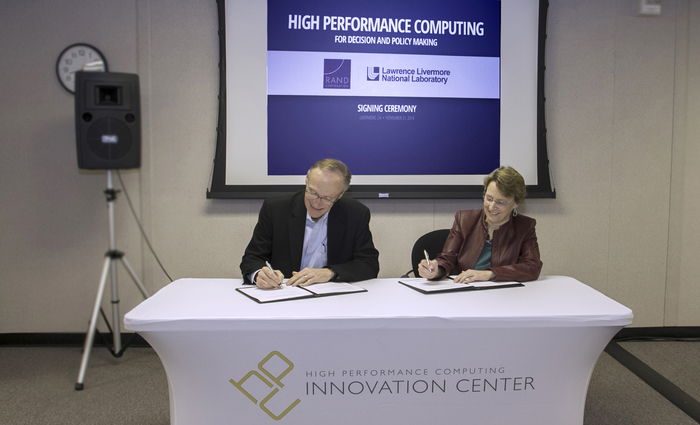Lab, RAND Corporation partner to advance policy analysis through supercomputing
 (Download Image)
Lawrence Livermore Science and Technology Deputy Director Greg Suski and Susan Marquis, RAND vice president, Emerging Policy Research and Methods and dean of the Pardee RAND Graduate School, sign a memorandum of understanding to expand the use of high performance computing (HPC) in decision analysis and policymaking. Photo by Julie Russell/LLNL
(Download Image)
Lawrence Livermore Science and Technology Deputy Director Greg Suski and Susan Marquis, RAND vice president, Emerging Policy Research and Methods and dean of the Pardee RAND Graduate School, sign a memorandum of understanding to expand the use of high performance computing (HPC) in decision analysis and policymaking. Photo by Julie Russell/LLNL
Lawrence Livermore National Laboratory (LLNL) and the RAND Corporation will collaborate to expand the use of high performance computing (HPC) in decision analysis and policymaking.
Lawrence Livermore Science and Technology Deputy Director Greg Suski and Susan Marquis, RAND vice president, Emerging Policy Research and Methods and dean of the Pardee RAND Graduate School, signed a memorandum of understanding on Friday, Nov. 21, during a ceremony at Livermore’s High Performance Computing Innovation Center (HPCIC). The arrangement provides a vehicle for the two organizations to explore the use of policy analysis methodologies with supercomputing applications to better inform decisions, especially where uncertainty of relations among actions, consequences and probabilities abound.
"The RAND Corporation is at the forefront of research for complex, multidimensional decision and policymaking," Suski said. "By coupling with Livermore’s leading HPC capabilities and expertise, this partnership promises to advance the use of simulation models for scenario discovery."
"The RAND partnership with Livermore offers the opportunity to pursue new understanding and potential solutions to even the most intractable current and future policy problems," Marquis said.
As an example of the partnership’s potential, LLNL and RAND revisited an earlier study on the water management of the Colorado River Basin. The initial effort required several days of dedicated computer time to evaluate a small number of policy options. The RAND-LLNL team was able to conduct the same analysis within hours while evaluating additional strategy options at the same time. Discussion and a demonstration of the work followed the signing ceremony.
"The ability to compare thousands of plausible futures in just minutes could revolutionize the way decision makers and the research community address some of today’s most pressing problems," Marquis said.
Future plans for the partnership include addressing policy problems in a variety of domains, including energy, environment and national security; exploring workforce development opportunities between the Lab and the Pardee RAND Graduate School; and forming joint business development and outreach opportunities.
"The union of RAND’s advanced robust decision-making (RDM) methodologies and LLNL’s HPC expertise will allow us to explore complex sets of decision options at a scale that was previously impossible" said Fred Streitz, director of the High Performance Innovation Center (HPCIC), which leads coordination of the partnership for LLNL. "We look forward to merging our strengths and delivering to decision makers the tools to confidently create more robust policies."
LLNL opened the High Performance Computing Innovation Center in 2011 to make Livermore’s leading supercomputing resources and expertise available to industry for technological and business innovation, with the ultimate goal of boosting the nation’s global economic competitiveness. The HPCIC is part of the Livermore Valley Open Campus, an area jointly created by LLNL and Sandia National Laboratories to facilitate collaboration with industry and academia across a broad range of disciplines.
The RAND Corporation is a research organization that develops solutions to public policy challenges to help make communities throughout the world safer and more secure, healthier and more prosperous.
Contact
 Anne M. Stark
Anne M. Stark
[email protected]
(925) 422-9799
Related Links
RAND CorporationHigh Performance Computing Inovation Center
Livermore Valley Open Campus
Computation at Lawrence Livermore
Tags
HPC, Simulation, and Data ScienceHPC Innovation Center
Featured Articles







